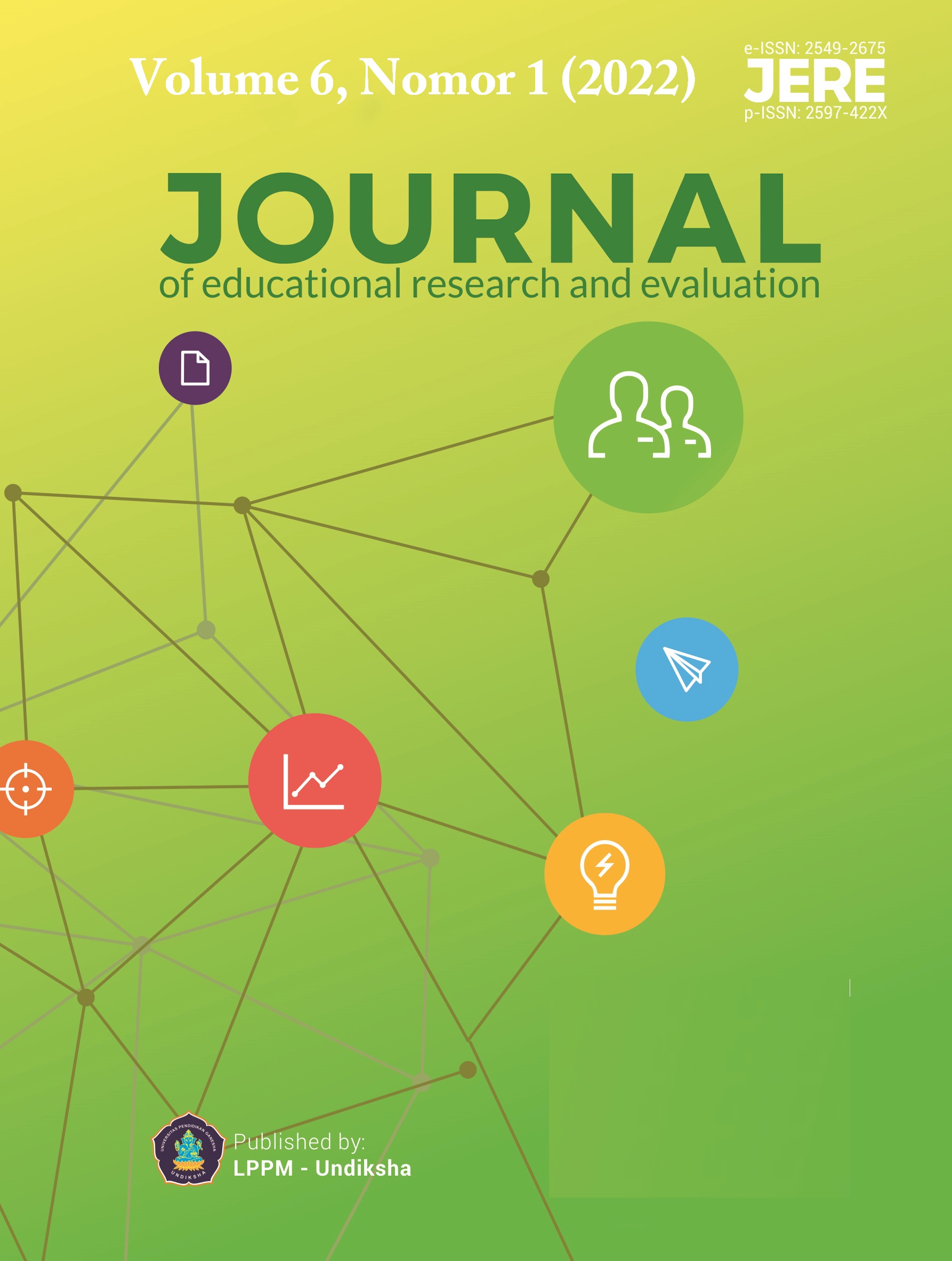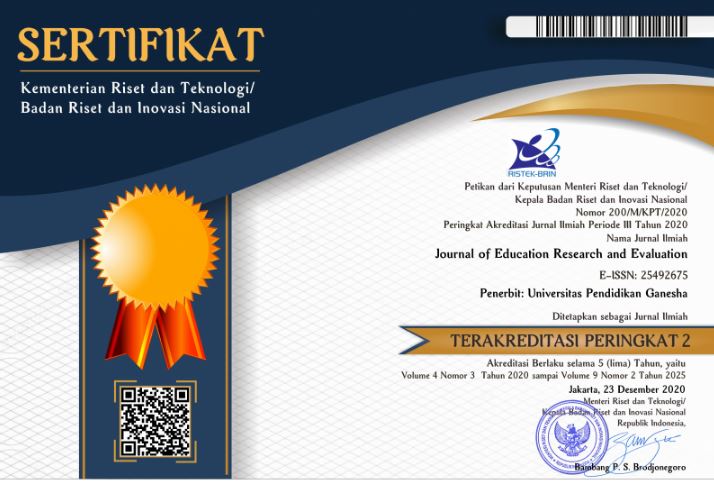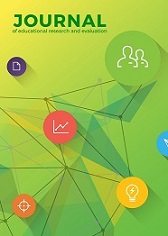Ispring: The Needs of Teachers and Students toward the ICT-Based Evaluation Tool
DOI:
https://doi.org/10.23887/jere.v6i1.34958Keywords:
online evaluation, application, ICTAbstract
An educator requires a learning evaluation tool as the assessment instrument. It can be printed or assisted with the information and communication technology. This qualitative research describes the learners and Indonesian language teachers’ needs toward ICT-based evaluation development for the tenth-grade students. The subjects were taken by purposive sampling based on the objectives and the research needs. They were 68 respondents and three Indonesian language teachers. This research used questionnaire and interview to collect the data. The obtained data were described by the researchers. Based on the findings, the students were already habituated to use ICT-based application. Thus, it indicated their needs of a better, multi-purpose, and multi-utility application so that the researcher recommended Ispring as the evaluation tool for the students. It is a multi-utility authoring e-learning to create various e-learning content types. It has some features to make interesting learning media and to promote presentation. It could be also combined with MS. PowerPoint and can be used to present, support electronic learning, distribute file, and create quizzes.
References
Agastya, N. L. P. M., Hati, G., & Machdum, S. V. (2018). Elemen-elemen pendukung proses assesment pada program pengembangan masyarakat untuk lingkungna kondusif bagi anak. Sosio Konsepsia, 8(01), 97–112. https://doi.org/10.33007/ska.v8i1.1458.
Aghaaminiha, M., Ghanadian, S. A., Ahmadi, E., & Farnoud, A. M. (2020). A machine learning approach to estimation of phase diagrams for three-component lipid mixtures. Biochimica et Biophysica Acta (BBA)-Biomembranes, 1862(9). https://www.sciencedirect.com/science/article/pii/S0005273620301905.
Aji, K. R., & Hartono, R. (2019). The Formative Assessment Backwash in English Instruction at Kristen Nusantara Vocational School. English Education Journal, 9(4), 541–557. https://journal.unnes.ac.id/sju/index.php/eej/article/view/32078.
Ames, H., Glenton, C., & Lewin, S. (2019). Purposive sampling in a qualitative evidence synthesis: A worked example from a synthesis on parental perceptions of vaccination communication. BMC Medical Research Methodology, 19(1), 1–10. https://doi.org/10.1186/s12874-019-0665-4.
Anwar, M. S., Choirudin, C., Ningsih, E. F., Dewi, T., & Maseleno, A. (2019). Developing an interactive mathematics multimedia learning based on ispring presenter in increasing students’ interest in learning mathematics. Al-Jabar: Jurnal Pendidikan Matematika, 10(1), 135–150. http://103.88.229.8/index.php/al-jabar/article/view/4445.
Ardiyani, D. K., & Hidayat, E. (2021). The implementation of EDDU as a source of ideas for digital German language teaching. Bahasa Dan Seni: Jurnal Bahasa, Sastra …, 49(1), 95–107. http://journal2.um.ac.id/index.php/jbs/article/view/19535.
Arikunto, S. (2013). Dasar-dasar Evaluasi Pendidikan (2nd ed.). Bumi Aksara.
Azhari, M., & Agus, F. (2016). Analisa kebutuhan sistem informasi manajemen perusahaan kayu ukir (SIMPKU) (study kasus CV. Embed). Informatika Mulawarman : Jurnal Ilmiah Ilmu Komputer, 11(1), 49. https://doi.org/10.30872/jim.v11i1.204.
Bakri, M., & Yusni, Y. (2021). Pemanfaatan youtube sebagai media pembelajaran menulis puisi. Silampari Bisa: Jurnal Penelitian Pendidikan Bahasa Indonesia, Daerah, Dan Asing, 4(1), 39–46. https://doi.org/10.31540/silamparibisa.v4i1.1183.
Çelik, H., Baykal, N. B., & Memur, H. N. K. (2020). Qualitative data analysis and fundamental principles. Journal of Qualitative Research in Education, 8(1), 379–406. https://doi.org/10.14689/issn.2148-2624.1.8c.1s.16m.
Celik, O., Yorulmaz, A., & Cokcaliskan, H. (2021). Pre-service primary school teachers’ beliefs about the consistency of the teacher training program on the formation of their teacher identity. International Online Journal of Education and Teaching, 8(2). https://eric.ed.gov/?id=EJ1294368.
Chong, M. S. F., Shahrill, M., & Li, H. C. (2019). The integration of a problem-solving framework for Brunei high school mathematics curriculum in increasing student’s affective competency. Journal on Mathematics Education, 10(2), 215–228. https://doi.org/10.22342/jme.10.2.7265.215-228.
Chotijah, H. ., & Suparman. (2017). Analisis kebutuhan pengembangan buku panduan guru implementasi lesson study pada pembelajaran matematika sekolah dasar. In The 5th Urecol Procediding, February, 920–925.
Coombs, C. (2017). Coherence and transparency: some advice for qualitative researchers. Production, 27, 1–8. https://doi.org/10.1590/0103-6513.006817.
Del Buono, M. G., Arena, R., Borlaug, B. A., Carbone, S., Canada, J. M., Kirkman, D. L., & Abbate, A. (2019). Exercise intolerance in patients with heart failure: JACC state-of-the-art review. Journal of the American College of Cardiology, 73(17), 2209–2225. https://doi.org/10.1016/j.jacc.2019.01.072.
Dewi, S. L. A., & Caropepoka, R. M. (2020). Perilaku generasi x dan generasi millenial dalam penggunaan media sosial. Jurnal Inovasi, 14(1). https://doi.org/10.33557/jurnalinovasi.v14i1.946.
Diken, E. H. (2020). The comparision between the cognitive and metacognitive strategies used by the eighth grade students to solve multiple-choice questions on “photosynthesis and respiration.” European Journal of Educaiton Studies, 7(4), 179–201. https://doi.org/10.5281/zenodo.3820871.
Ernawati, N., & Kuncoro, A. (2016). Determinan persepsi etika mahasiswa akuntansi dengan love of money sebagai variabel intervening (studi kasus mahasiswa akuntansi Universitas Muria Kudus). Jurnal Riset Akuntansi Terpadu, 9(1). https://doi.org/10.35448/jrat.v9i1.4279.
Etikan, I., Musa, S. A. M., & Alkassim, R. S. (2016). Comparison of convenience sampling and purposive sampling. American Journal of Theoretical and Applied Statistics, 5(1), 1. https://doi.org/10.11648/j.ajtas.20160501.11.
Fadillah, A., Bilda, W., Saleh, H., & Yenni, Y. (2021). Design of Interactive Learning Media in The Covid-19 Pandemic Time Using Ispring. Prima: Jurnal Pendidikan Matematika, 5(1), 1–10. http://jurnal.umt.ac.id/index.php/prima/article/view/3260.
Febyronita, D., & Giyanto. (2016). Survei tingkat kemampuan siswa dalam mengerjakan tes berbentuk jawaban singkat (short answer test) pada mate pelajaran IPS Terpadu (Geografi) kelas VII di SMP Negeri 1 Mesuji tahun pelajaran 2015/2016. Jurnal Swarnabhumi, 1(1), 17–21.
Georgieva, S. (2019). The role of feedback when training pre-service native language teachers. V International Forum on Teacher Education, 1, 323–337. https://doi.org/10.3897/ap.1.e0196.
Gizatulina, D., Ismaeva, F., Solnyshkina, M., Martynova, E., & Yarmakeev, I. (2020). Fluctuations of text complexity: the case of Basic State Examination in English. SHS Web of Conferences, 88, 02001. https://doi.org/10.1051/shsconf/20208802001.
Guetterman, T. C. (2015). Descriptoin of sampling practices within five approaches to qualitative research in education and health sciences. Forum Qualitative Sozialforschung / Forum: Qualitative Social Research, 16(2), Art. 25. https://digitalcommons.unl.edu/edpsychpapers/263/.
Harsiati, T., & Priyatni, E. T. (2017). Karakteristik teks literasi membaca pada Programme for International Student Assessment (PISA). BIBLIOTIKA: Jurnal Kajian Perpustakaan Dan Informasi, 68–70.
Hidayat, R., Susanto, F., Rahayu, E. M., Hertiki, H., Arbani, A. N., & Soelistijowati, J. O. (2021). Pemanfaatan quiz bot telegram dalam pembelajaran menyimak bahasa Inggris. Jurnal Penamas Adi Buana, 4(02), 76–86. http://jurnal.unipasby.ac.id/index.php/penamas/article/view/2784.
Hidayatullah, S., Waris, A., & Devianti, R. C. (2018). Perilaku generasi milenial dalam menggunakan aplikasi Go-Food. Jurnal Manajemen Dan Kewirausahaan, 6(2), 240–249. https://doi.org/10.26905/jmdk.v6i2.2560.
Istighfarini, T. E., Sudarti, S., & Yushardi, Y. (2021). Analisis pemahaman mahasiswa pendidikan fisika Universitas Jember melalui multirepresentasi verbal dan grafik tentang manfaatd an bahaya sinar UV bagi kesehatan. Journal Ilmiah Rinjani: Media Informasi Ilmiah Universitas Gunung Rinjani, 9(2), 51–56.
Jamalin, F., & Abdul, A. (2021). Arabic-Java writing system: how Javanese language adopts Arabic Script. 4, 43–58. https://ejournal.umm.ac.id/index.php/izdihar/article/view/11337.
Javaeed, A. (2018). Assessment of higher ordered thinking in medical education: multiple choice questions and modified essay questions. MedEdPublish, 7(2), 1–8. https://doi.org/10.15694/mep.2018.0000128.1.
Kholis, N., Kartowagiran, B., & Mardapi, D. (2020). Development and validation of an instrument to measure a performance of vocational high school. European Journal of Educational Research, 9(3), 955–966. https://doi.org/10.12973/EU-JER.9.3.955.
Kuncoro, A., & Husnurrosyidah, H. (2015). Kualitas layanan short message service (sms) terhadap efektifitas komunikasi dilingkungan organisasi kemahasiswaan. EKSIS, X(1), 42–51. http://ejournal.stiedewantara.ac.id/index.php/001/article/view/53.
Kuncoro, A., & Husnurrosyidah, H. (2017). Kinerja lembaga keuangan mikro syariah dan upaya untuk mempertahankan eksistensi perilaku masyarakat pedesaan. Jurnal Analisa Akuntansi Dan Perpajakan, 1(1), 63–74. https://doi.org/10.25139/jaap.v1i1.102.
Kusuma, D. (2019). Pusat kegiatan kaum millenial. Jurnal Sutra: Sain, Teknologi, Urban, Perancangan, Arsitektur, 1(2), 1117–1128. http://journal.untar.ac.id/index.php/jstupa/article/view/4379.
Liu, H., Chen, R., Cao, S., & Lv, H. (2020). Evaluation Of College English Teaching Quality Based On Grey Clustering Analysis. International Journal of Emerging Technologies in Learning, 16(2), 173–187. https://doi.org/10.3991/ijet.v16i02.19727.
Madrazo, A. L., & Dio, R. V. (2020). Contextualized learning modules in bridging students’ learning gaps in calculus with analytic geometry through independent learning. Journal on Mathematics Education, 11(3), 457–476. https://doi.org/10.22342/jme.11.3.12456.457-476.
Madzlan, N. A., & Mahmud, C. T. binti. (2018). Perception of the attitudinal function of intonation in responding to Yes/No questions: A study of non-native English language teachers. Studies in English Language and Education, 5(2), 217–229. https://doi.org/10.24815/siele.v5i2.10476.
Manan, A., Fadhilah, M. A., Kamarullah, & Habiburrahim. (2020). Evaluating paper-based toefl preparation program using the context, input, process, and product (Cipp) model. Studies in English Language and Education, 7(2), 457–471. https://doi.org/10.24815/siele.v7i2.16467.
Manoppo, Y., & Manuhutu, J. B. (2020). Analisa skala kemampuan mahasiswa kimia melalui tes entry behavior methode computerize assisted test (CAT) menggunakan item respon theory (IRT). Molluca Journal of Chemistry Education (MJoCE), 10(1), 19–27. https://doi.org/10.30598/mjocevol10iss1pp19-27.
Nurlela, Sofyan, R., & Ganie, R. (2021). Thematic characteristics of the orientation part of the english version of hikayat deli text. Studies in English Language and Education, 8(2), 818–832. https://doi.org/10.24815/siele.v8i2.18731.
Prasarti, S., & Prakoso, E. T. (2020). Karakter dan perilaku milineal: peluang atau ancaman bonus demografi. Consilia : Jurnal Ilmiah Bimbingan Dan Konseling, 3(1), 10–22. https://doi.org/10.33369/consilia.v3i1.11981.
Riyanto, B., Zulkardi, Putri, R. I. I., & Darmawijoyo. (2019). Senior high school mathematics learning through mathematics modeling approach. Journal on Mathematics Education, 10(3), 425–444. https://doi.org/10.22342/jme.10.3.8746.425-444.
Rofi, S., & Fatkurochman, H. (2021). Penyusunan soal terintegrasi kisi-kisi soal berbasis aplikasi sederhana bagi guru di MTs Baitul Arqom. ABDI Indonesia, 1(1), 23–30. http://jurnal.unmuhjember.ac.id/index.php/ABDI/article/view/5320.
Saputri, I., Nurkamto, J., & Wahyuni, D. S. (2018). The implementation of authentic assessment in English language teaching. English Education Journal2, 6(3). https://doi.org/10.20961/eed.v6i3.35881.
Setyowati, W., Ibnu, S., & Kusumaningrum, I. K. (2020). Penerapan model pembelajaran react-tpk terhadap pemahaman konsep siswa dengan kemampuan awal berbeda. Jurnal Pendidikan: Teori, Penelitian, Dan Pengembangan, 5(3), 414. https://doi.org/10.17977/jptpp.v5i3.13322.
Sidabutar, G. D. U., Putrayasa, I. B., & Martha, I. N. (2017). Kualitas butir soal ulangan akhir semester ganjil bahasa Indonesia kelas IX SMP Negeri 2 Singaraja tahun pelajaran 2016/2017 ditinjau dari segi taraf kesukaran, daya beda, dan fungsi pengecoh. Jurnal Pendidikan Bahasa Dan Sastra Indonesia Undiksha, 7(2), 1–12. https://ejournal.undiksha.ac.id/index.php/JJPBS/article/view/11586.
Singamurti, M. M. (2020). Pengembangan instrumen penilaian model two-tier multiple choice question (TTMCQ) pada materi pancadharma. INFERENSI: Jurnal Penelitian Sosial Keagamaan, 14(1), 97–120. https://doi.org/10.18326/infsl3.v14i1.97-120.
Singh, C. K. S., Ong, E. T., Singh, T. S. M., Maniam, M., & Mohtar, T. M. T. (2021). Exploring esl learners’ reading test taking strategies. Studies in English Language and Education, 8(1), 227–242. https://doi.org/10.24815/siele.v8i1.18130.
Sulaeman, N. F., Komariyah, L., & Yani, S. F. (2018). Analysis of high school students’ misconception in energy using ordered and reasoning multiple choice. Jurnal Pembelajaran Fisika, 7(2), 210–216. https://jurnal.unej.ac.id/index.php/JPF/article/download/7932/5586.
Sumarwati, & Budiyono. (2017). Peningkatan kompetensi menyusun dan mengajarkan soal cerita matematika bagi guru SD pedesaan. Aksiologiya: Jurnal Pengabdian Kepada Masyarakat, 5(1), 61–78. http://dx.doi.org/10.30651/aks.v5i1.4438.
Suryani, I., & Rasdawita. (2018). Pengembangan Bahan Ajar Menulis Naskah Drama Berbasis Pendekatan Kontekstual di FKIP Universitas Jambi PENDAHULUAN Peraturan Rektor Universitas Jambi Nomor 02 tahun 2017 , dosen sebagai ilmuan memiliki tugas mengembangkan suatu cabang ilmu pengetahuan dan. Pena, Jurnal Pendidikn Bahasa Dan Sastra, 8(1), 80–92. https://online-journal.unja.ac.id/pena/article/view/6565.
Syathroh, I. L., Musthafa, B., & Purnawarman, P. (2019). Providing teaching resources for young learners classes: best practices in EFL context. ELT in FOcus, 2(December). https://doi.org/10.35706/eltinfc.v2i2.3054.
Tarmizi, P., Setiono, P., Amaliyah, Y., & Agrian, A. (2019). Analisis butir soal pilihan ganda tema sehat itu penting kelas V SD Negeri 04 Kota Bengkulu. Elementary School Education Journal, 3(1), 93–103. http://journal.um-surabaya.ac.id/index.php/pgsd/article/view/7090.
Tien Bui, D., Moayedi, H., Gör, M., Jaafari, A., & Foong, L. K. (2019). Predicting slope stability failure through machine learning paradigms. ISPRS International Journal of Geo-Information, 8(9), 395. https://www.mdpi.com/528376.
Usman, B., Muslim, A., Champion, I. C. R., & Samad, I. A. (2018). Progressive peer evaluation: Important but absent in EFL speaking classes. Studies in English Language and Education, 5(2), 308–327. https://doi.org/10.24815/siele.v5i2.11115.
Utomo, T. (2018). Perbedaan kelompok generasi & tantangan yang dihadapi oleh perguruan tinggi A. PERSONIFIKASI, 9(1). https://journal.trunojoyo.ac.id/personifikasi/article/view/6742.
Valenci, C., & Winata, T. (2020). Ruang kreatif digital. Jurnal Sains, Teknologi, Urban, Perancangan, Arsitektur (Stupa), 1(2), 2075. https://doi.org/10.24912/stupa.v1i2.4435.
Wahyuni, G., Ibnu, S., & Suharti, S. (2019). Perbedaan Pemahaman Konsep Siswa sebagai Hasil Penerapan Model Pembelajaran LC 5E-Analogi dan LC 5E. Jurnal Pendidikan: Teori, Penelitian, Dan Pengembangan, 4(4), 537. https://doi.org/10.17977/jptpp.v4i4.12361.
Wang, Y., Sun, C., & Guo, Y. (2020). A Multi-Attribute Fuzzy Evaluation Model for the Teaching Quality of Physical Education in Colleges and Its Implementation Strategies. International Journal of Emerging Technologies in Learning, 16(2), 159–172. https://doi.org/10.3991/ijet.v16i02.19725.
Wati, N. K. R., Suandi, I. N., & Wendra, I. W. (2015). Kualitas butis soal ulangan akhir semester ganjil bahasa Indonesia kelas XI SMA Negeri 2 Singaraja tahun pelajaran 2015/2016 dari segi taraf kesukaran, daya pembeda, dan fungsi pengecoh. Jurnal Pendidikan Bahasa Dan Sastra Indonesia Undiksha, 3(1). https://ejournal.undiksha.ac.id/index.php/JJPBS/article/view/7202.
Wijaya, A., Retnawati, H., Setyaningrum, W., Aoyama, K., & Sugiman. (2019). Diagnosing students’ learning difficulties in the eyes of Indonesian mathematics teachers. Journal on Mathematics Education, 10(3), 357–364. https://doi.org/10.22342/jme.10.3.7798.357-364.
Winayarti, E., Handarsari, E., & Fathurohman, A. (2012). Analysis pengembangan model pembelajaran “Wisata Lokal” pada pembelajaran sains. Seminar Nasional Hasil Penelitian, 332–341. https://jurnal.unimus.ac.id/index.php/psn12012010/article/download/527/576.
Wulandari, N. P., Novitasari, D., Junaidi, J., & Baidowi, B. (2019). Pandangan mahasiswa: pentingnya kemampuan informasi dan komunikasi teknologi (ICT) bagi calon guru matematika. Jurnal Pendidikan Matematika, 5(2), 61–70. http://jurnal.fkip.unila.ac.id/index.php/MTK/article/view/22340.
Yang, S., Leshchinsky, B., Cui, K., Zhang, F., & Gao, Y. (2021). Influence of failure mechanism on seismic bearing capacity factors for shallow foundations near slopes. Géotechnique, 71(7), 594–607. https://www.icevirtuallibrary.com/doi/abs/10.1680/jgeot.19.P.329.
Downloads
Published
How to Cite
Issue
Section
License
Copyright (c) 2022 Journal of Education Research and Evaluation

This work is licensed under a Creative Commons Attribution-ShareAlike 4.0 International License.
Authors who publish with the Journal of Evaluation and Research in Education (JERE) agree to the following terms:
- Authors retain copyright and grant the journal the right of first publication with the work simultaneously licensed under a Creative Commons Attribution License (CC BY-SA 4.0) that allows others to share the work with an acknowledgment of the work's authorship and initial publication in this journal.
- Authors are able to enter into separate, additional contractual arrangements for the non-exclusive distribution of the journal's published version of the work (e.g., post it to an institutional repository or publish it in a book), with an acknowledgment of its initial publication in this journal.
- Authors are permitted and encouraged to post their work online (e.g., in institutional repositories or on their website) prior to and during the submission process, as it can lead to productive exchanges, as well as earlier and greater citation of published work. (See The Effect of Open Access)











